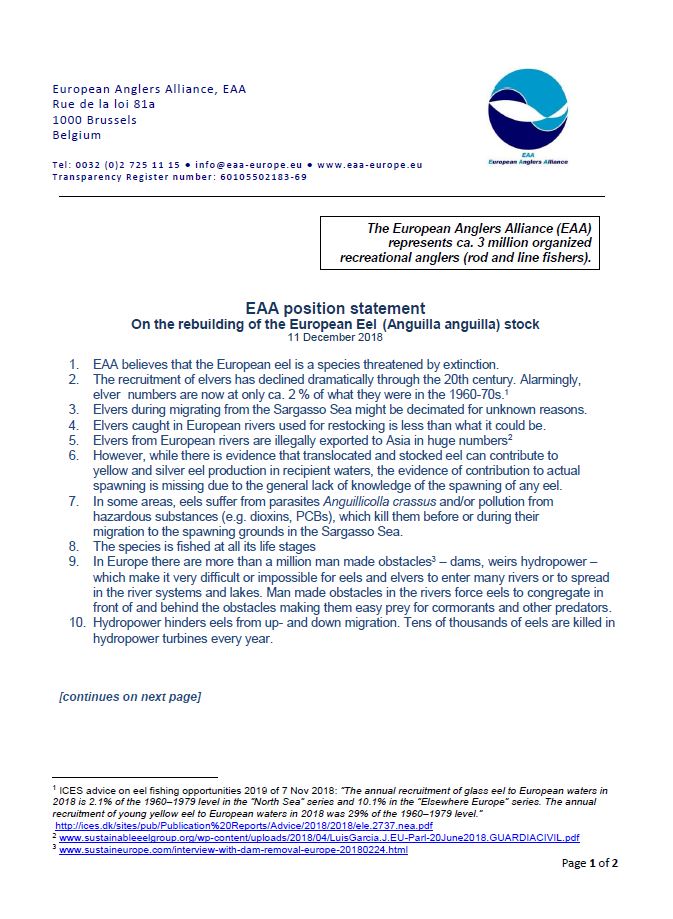EAA position on the rebuilding of the European Eel (Anguilla anguilla) stock

- EAA believes that the European eel is a species threatened by extinction.
- The recruitment of elvers has declined dramatically through the 20th century. Alarmingly, elver numbers are now at only ca. 2 % of what they were in the 1960-70s.
- Elvers during migrating from the Sargasso Sea might be decimated for unknown reasons.
- Elvers caught in European rivers used for restocking is less than what it could be.
- Elvers from European rivers are illegally exported to Asia in huge numbers
- However, while there is evidence that translocated and stocked eel can contribute to yellow and silver eel production in recipient waters, the evidence of contribution to actual spawning is missing due to the general lack of knowledge of the spawning of any eel.
- In some areas, eels suffer from parasites Anguillicolla crassus and/or pollution from hazardous substances (e.g. dioxins, PCBs), which kill them before or during their migration to the spawning grounds in the Sargasso Sea.
- The species is fished at all its life stages
- In Europe there are more than a million man made obstacles – dams, weirs hydropower – which make it very difficult or impossible for eels and elvers to enter many rivers or to spread in the river systems and lakes. Man made obstacles in the rivers force eels to congregate in front of and behind the obstacles making them easy prey for cormorants and other predators.
- Hydropower hinders eels from up- and down migration. Tens of thousands of eels are killed in hydropower turbines every year.
The EAA stresses that:
- ICES latest advice (of 7 Nov 2018) has it that: “..when the precautionary approach is applied for European eel, all anthropogenic impacts (e.g. caused by recreational and commercial fishing on all stages, hydropower, pumping stations, and pollution) that decrease production and escapement of silver eels should be reduced to – or kept as close to – zero as possible in 2019.”
- Eels are on the CITES list Appendix II
- Much more needs be done to improve the eel habitats, including removal of or altering obstacles in the eels’ migration routes
- The European Eel Management Plan adopted in 2007 , with regard to the freshwater habitats, has not delivered as hoped for.
- ICES finds that the 40% ‘escape-to-open-sea‘ target in that Plan was set too low.
- Eel fishing at sea: The plan of 2007 requests: “50% reduction in catches or effort compared to the 2004-06 average.” Additionally, the fishing opportunities for 2018 introduced a temporary prohibition to fish commercially for European eel of an overall length of 12 cm or longer “for a consecutive three-month period to be determined by each Member State between 1 September 2018 and 31 January 2019.”
* note: this temporary prohibition doesn’t apply to the Mediterranean Sea, neither to recreational sea fishing.
The EAA calls for:
- All anthropogenic impacts (e.g. caused by hydropower, pumping stations, and pollution etc.) that decrease production and escapement of silver eels should be reduced to – or kept as close to – zero as possible.
- Stop for all targeted fishing for eels, commercial as well as recreational, at all its life stages, and compulsory release of all eel by-catches
- Fishing for eels and elvers should only be allowed for recovery purposes (e.g. tagging, monitoring and re-stocking)
- Stop for all sales of eels, with the exception of elvers for the purpose of restocking in European waters.
- More efforts on control to restrict illegal fishing and sales of eel in all its life stages.
- Increase the efforts to find the place in the Sargasso Sea where eels breed, for the area to be protected, and break the code how to breed eels in captivity.
*Minority statement by the Deutscher Angelfischerverband (DAFV) in the context of the 2018 EAA position paper on rebuilding of the European Eel stock (Updated June 2022):
"The DAFV finds that a total fishing ban is a counter-productive way to protect and rebuild eel stocks. It would lead to a withdrawal of organized anglers from restocking and monitoring eels in Germany on a voluntary basis. Moreover, the financial engagement of organized anglers worth millions of euros per year would run dry. However, the DAFV agrees that a temporal fishing closure should be timed in accordance with downstream migration peaks to protect spawners that have reached coastal waters. The DAFV is convinced that a well-controlled eel fishery along with restocking as recovery measure, and a responsible eel aquaculture sector, provides significant benefits to the eel stock recovery and its sustainable use. Prohibiting all eel fisheries will likely boost the very lucrative, illegal market, and consequently create much worse effects on the stock than a responsible and well-controlled market that is compliant with the EU Eel Regulation (which has been evaluated and identified as fit for purpose). The path taken to rebuild stocks based on regional eel management plans, should therefore be continued."
--
For notes and references please download the position paper
Download: